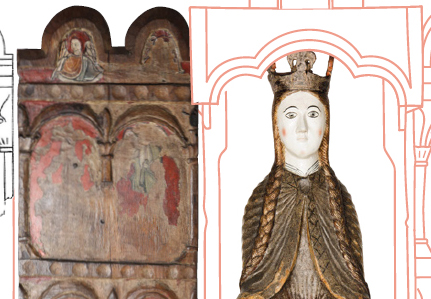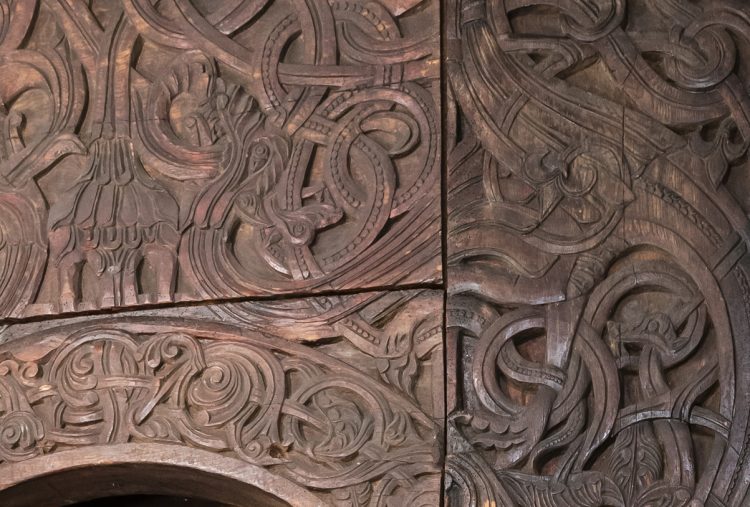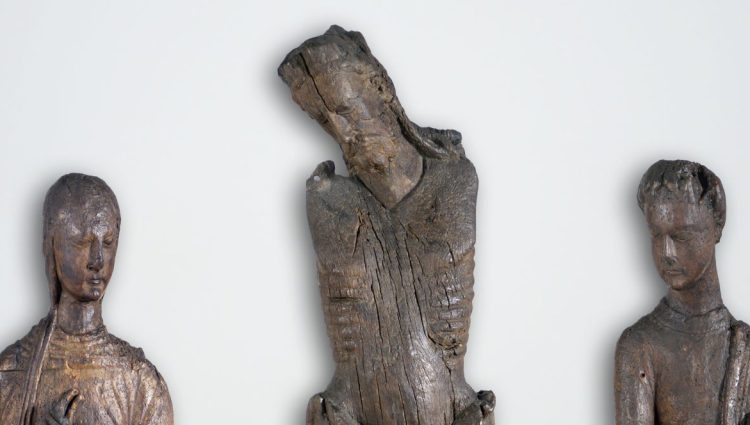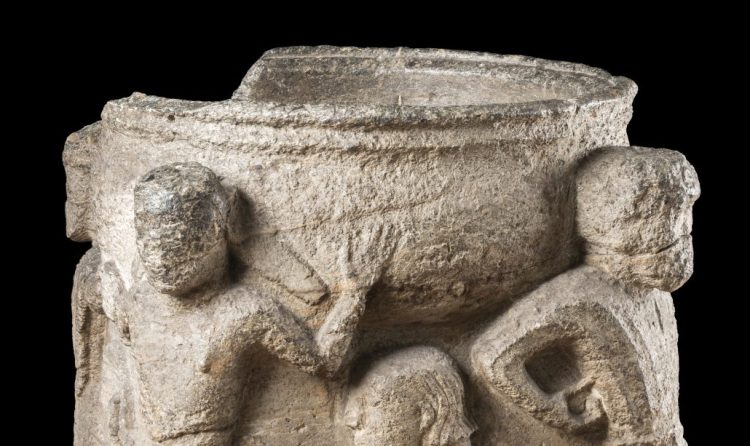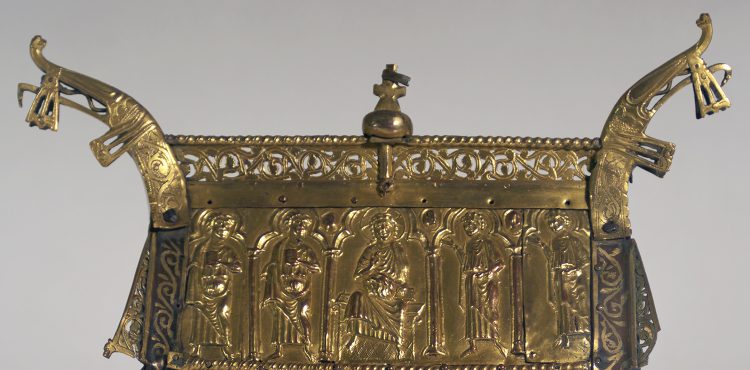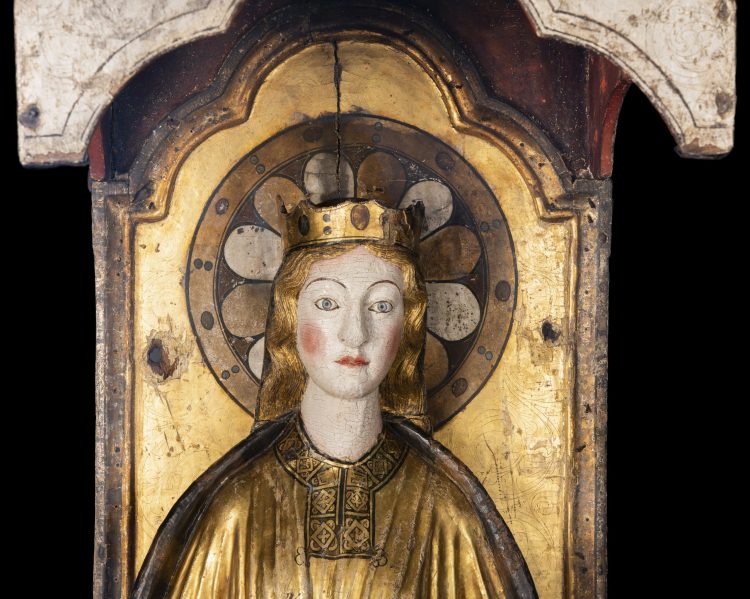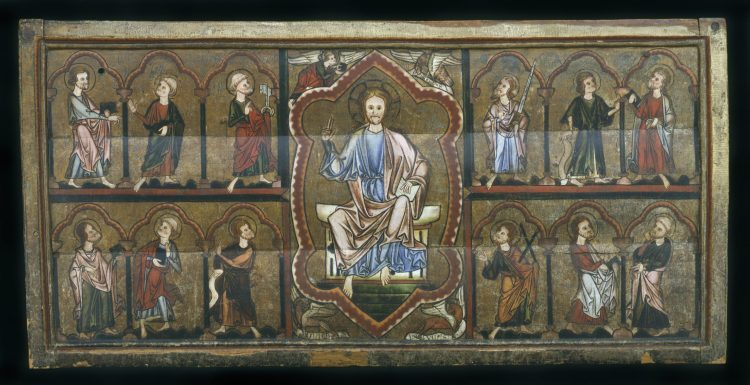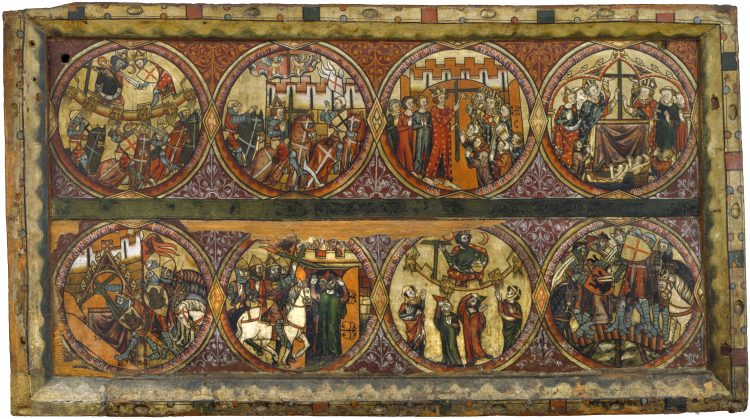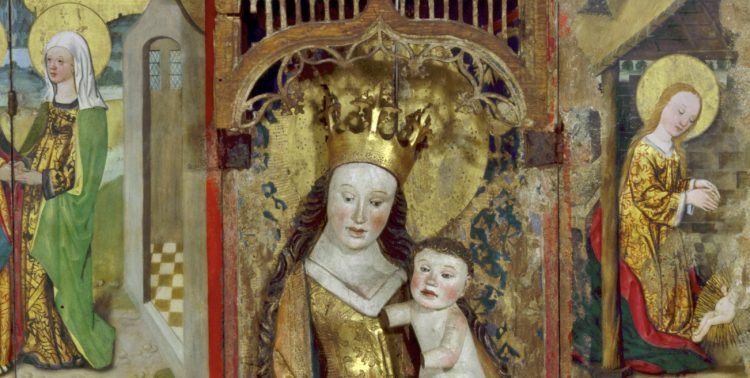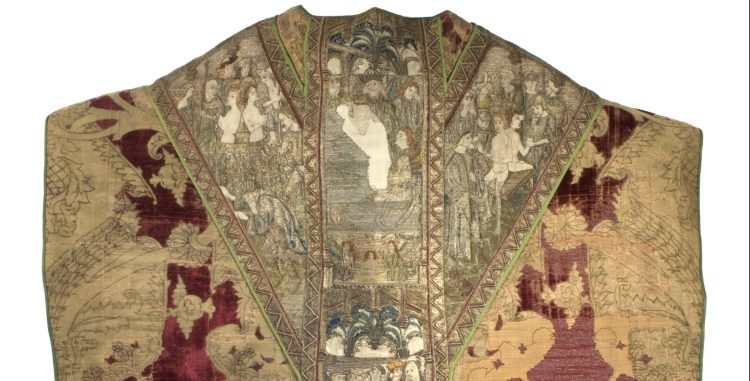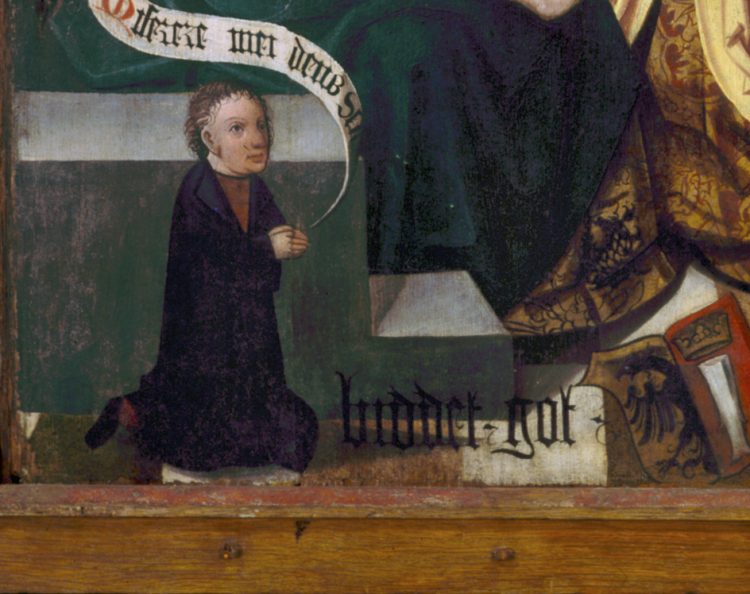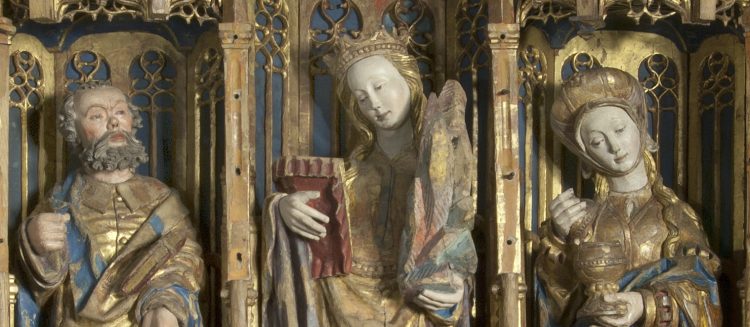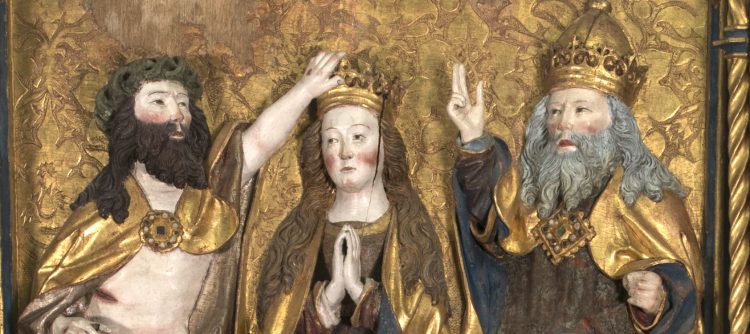This crucifix is among the oldest in Norway and probably originated around the middle of the twelfth century. The slender figure maintains a standing position before the cross, its knees slightly bent, as was usual in the Romanesque style. Carved slits in his arms and breast evoke stylized ribs and muscles. Christ wears a green…Continue reading 1 Romanesque Crucifix from Leikanger
Category: 25 selected objects
2 Head of a Figure from Urnes
This head of a tonsured figure, which has also been called ‘monk’s head’ (‘munkehodet’), is one of the few wooden sculptures from the late twelfth century preserved in Norway. In terms of style, the head can be compared to the angel from an Entombment group now in the Bode-Museum in Berlin (inv. no. 2969), which…Continue reading 2 Head of a Figure from Urnes
3 Marian shrine from Urnes
This enthroned Virgin is one of the earliest preserved Marian sculptures in Norway and can be dated to the second half of the twelfth century. Mary sits frontally on a folding throne decorated with animal heads and addresses the onlooker with a poignant gaze. Her skin is whitish, her cheeks are reddish, and her eyes…Continue reading 3 Marian shrine from Urnes
4 Portals and Stave from the Stave Church in Stedje
Both portals, which can be dated to around 1180, stem from the stave church at Stedje at the Sognefjord, which was demolished in 1867. Their carved decorations place them in the so-called Sogn-Valdres II type, which was widespread in this region. The undecorated base of the first portal (Stedje I) is topped by a palmette…Continue reading 4 Portals and Stave from the Stave Church in Stedje
5 Calvary Group from Giske
On the island of Giske, north of Ålesund, stands a well-built twelfth-century church of white marble that was founded by a prominent nobleman. From this church stems a three-figure Romanesque Calvary group that, despite its battered state, still betrays its remarkable artistic quality. The original polychromy, the cross and arms of the Christ figure, as…Continue reading 5 Calvary Group from Giske
6 Baptismal Font from Os
This thirteenth-century font from Os has a remarkable shape and a rich iconography. The circular basin with a profiled rim is surrounded by four supporting corner figures that create a transition to the square base. The rather coarsely carved figures represent two bearded men, a bishop with a mitre and crozier and a woman with…Continue reading 6 Baptismal Font from Os
7 Crucifix from Fresvik
This high-quality sculpture, which has lost its cross, shows Christ crucified. His body is slightly bent, his crowned head somewhat bowed to the right, and his eyes closed. The figure wears a long loin cloth with a fold at the top that shows the red inner lining. One foot is placed over the other and…Continue reading 7 Crucifix from Fresvik
8 Relic Shrine from Filefjell
This relic shrine is built from oak and covered with bas-reliefs of gilded copper. The shrine stems from the stave church, abandoned in 1808, of St Thomas – probably St Thomas Becket – on the Filefjell, located on a plateau along an important road between eastern and western Norway. The shrine has the form…Continue reading 8 Relic Shrine from Filefjell
9 Marian Shrine from Hove
The so-called ‘Hove Madonna’ is among the most outstanding medieval sculptures in Norway. Mary and Child are both largely covered in gold leaf and the inside of the Virgin’s cloak, painted in blue and white, imitates vair (squirrel fur) or ermine. The crowned Virgin is seated frontally on a throne with black painted window motives…Continue reading 9 Marian Shrine from Hove
10 Marian shrine from Kyrkjebø
This Virgin of the Sedes Sapientiae (‘Throne of Wisdom’) type is seated frontally on a throne with painted architectural decorations on the sides. Mary wears a golden robe that falls down in thick V-shaped folds and is fastened with a golden belt. Her golden mantle, draped over her right knee, is lined with painted imitation…Continue reading 10 Marian shrine from Kyrkjebø
11 Altar Frontal from Ulvik
Altar frontals served to decorate the front of the altar in medieval churches. Painted wooden frontals were once widespread throughout Europe, but the only surviving concentrations of this object type are now found in Norway and Catalonia. This painted example from the vanished stave church at Ulvik on the Hardangerfjord is one of the oldest…Continue reading 11 Altar Frontal from Ulvik
12 Church Models from Kinsarvik and Borgund
When these wooden church models entered the museum, they were registered (with a question mark) as reliquaries or as tabernacles for the storage of the consecrated Host. In the 1970s, however, Bernt C. Lange convincingly demonstrated that such miniature churches served as crowning elements to tabernacle shrines. The church model from Kinsarvik has a T-shaped…Continue reading 12 Church Models from Kinsarvik and Borgund
13 St. Olav from Dale
In this life-sized sculpture, the King, St Olav, is seated on an architecturally shaped throne with corner posts and a cushion on top, painted in ‘dual shading’. He wears a fastened, imitation-golden robe that falls to his ankles, and an opened red mantle lined with imitation fur. He has a young, bearded face and half-long…Continue reading 13 St. Olav from Dale
14 Painted Altar Ensemble from Årdal
The central section of this frontal represents the enthroned Abbot, St Botolph, who is identified by the inscription SCS: BOTOLFUS over the seven-lobed framing arch. His left hand holds a crozier while he makes a blessing gesture with his right. The saint is surrounded by four narrative scenes. The martyrdom of St Olav at the…Continue reading 14 Painted Altar Ensemble from Årdal
15 Altar Frontal from Kinsarvik
This altar frontal from Kinsarvik on the Hardangerfjord shows a multi-figured Crucifixion scene in a simultaneous narrative inside a multi-lobed frame in the central section. Christ hangs from the cross in a slightly bent posture. His head bows to the right side and he is looking at his mother Mary. St John the Evangelist stands…Continue reading 15 Altar Frontal from Kinsarvik
16 Five Aquamaniles
Ritual rules prescribed that priests should wash their hands before and after Communion, as a sign of purity and to prevent any crumbs of the consecrated Host from becoming desecrated. To this end, a special vessel was used, called an aquamanile (aqua=water, manus=hand), which usually took the shape of an animal carrying associations with physical…Continue reading 16 Five Aquamaniles
17 A Crucifixus Dolorosus from Fana
From the cross, which is composed of two trunks with cut-off branches, hangs a wound-covered, emaciated Christ. His rib cage is lifted forwards, and splinters from the lance can be seen in his side wound. Blood from the wound sin his hands trickles down in thick drops along his arms. On his shoulder-length golden hair…Continue reading 17 A Crucifixus Dolorosus from Fana
18 Altar Frontal from Nedstryn
This painted panel from Nedstryn was the first altar frontal to enter the Bergen collection, and the subject of the first art historical research paper published by its founder, Wilhem Frimann Koren Christie. It is composed of two wide boards set inside a frame with oval incisions. The entire surface is occupied by eight circles…Continue reading 18 Altar Frontal from Nedstryn
19 Door ring from Fana
Lions’ heads with a ring in their mouths have decorated the doors of sanctuaries since antiquity. Their symbolism refers to aspects including vigilance and protection from evil powers, and they were sometimes also used for swearing oaths. This expressive lion’s head, with a (damaged) ring, originally decorated the door of the southern nave portal…Continue reading 19 Door ring from Fana
20 Marian Shrine from Brekke
This late Gothic tabernacle shrine from Brekke on the Sognefjord represents a type that was widespread in central and northern Europe during the late Middle Ages. The shrine was probably produced in northern Germany, possibly Lübeck. The figure of the standing Virgin and Child has almost completely preserved its original polychromy. The Virgin has long,…Continue reading 20 Marian Shrine from Brekke
21 Painted Banner from Lavik
This staff with banner, which originates from Lavik on the Sognefjord, entered the collection as early as 1826. The red painted shaft ends in a cross with square ends, whose surface is decorated with black stencilled rosettes. The same motifs recur on the banner, which is attached to a horizontal wooden rod. Its lower half…Continue reading 21 Painted Banner from Lavik
22 Chasuble and Paper Templates from Hjørundfjord
This chasuble from red-golden Italian brocade fabric with pomegranate-motifs is decorated at the front and back with finely worked embroidered forked crosses showing scenes from the lives of St Crispin and St Crispinian in addition to the Throne of Grace. The chest-piece at the front shows both saints as the patrons of shoemakers at work…Continue reading 22 Chasuble and Paper Templates from Hjørundfjord
23 Epitaph for Gert Alant
This panel featuring the Adoration of the Magi shows the Virgin Mary in a robe of gold brocade and a blue cloak sitting with the naked Christ child on her lap. A grey-haired king wearing a precious mantle of gold brocade kneels before her presenting a bowl full of golden coins to the child. Behind…Continue reading 23 Epitaph for Gert Alant
24 Winged Altarpiece from Austevoll
This triptych from the medieval church of Austevoll on the island of Sandtorr, south of Bergen, is one of the best-preserved late Gothic altarpieces in Norway. Inside the central shrine are three chapel-like niches with richly traceried walls and intricate openwork baldachins that are filled with fully rounded, richly gilded sculptures. In the centre stands…Continue reading 24 Winged Altarpiece from Austevoll
25 Double-Winged Altarpiece from Uggdal
Together with the winged altarpiece from Austevoll (MA 283), this example from Uggdal (formerly Opdal) on the island of Tysnes is preserved in its entirety. The central chest shows a relief group representing the Coronation of the Virgin Mary by Christ (left) and God the Father (right), with the Holy Spirit appearing in the shape…Continue reading 25 Double-Winged Altarpiece from Uggdal
